The mystery of how dinosaurs had sex
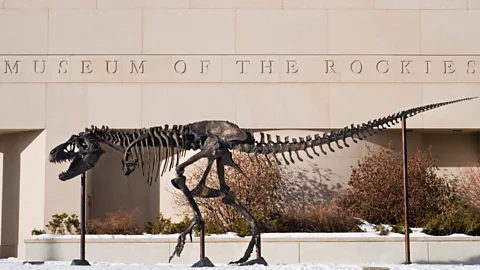 Alamy
AlamyThe sordid details of how dinosaurs got it on have long eluded scientists. Now there's a new idea emerging – could their most eccentric features tell us how they did it?
I'm sitting in Jakob Vinther's office, trying to get my head around whether tyrannosaurs had – there's no easy way to write this – penises. "So somebody has to be…" I stutter, becoming increasingly flustered. "…penetrated", finishes my host matter-of-factly.
We're at the University of Bristol, in the UK, where Vinther is a professor of macroevolution, specialising in the fossil record. I survey the room, mostly to avoid eye contact while I recover. It's exactly what your inner child would hope for from a palaeontologist.
The bookshelves are laden with a kind of fossil lasagne, where layers of academic tomes and paperwork are muddled up with relics from a lost world. Among the highlights are an ancient insect, with its delicate wing veins and mottled colouration clearly visible, the remains of a vampire squid with its black ink sacs so well-preserved they still contain melanin, and strange ancient worms related to those found today on coral reefs. In the corner is an antique wooden chest with drawers that – I hope – contain all kinds of other exciting petrified remains. The place feels like a cross between a museum and a library.
Mere feet away is the star of the show – a psittacosaurus, literally "parrot-lizard". This sweet little beaked herbivore and close relative of the triceratops is thought to have padded through the forests of what is now Asia around 133-120 million years ago. The specimen I'm looking at is world-famous – not for its skin, which is so intact you can still make out the streaky pattern on its body, or for its tail, which includes a distinctive spiky fringe of feathers. No, this dinosaur is best-known as the one that left its bottom behind for future generations to study (More on that later.)
I shift my attention back to our conversation. Vinther is telling me about a particularly titillating find from a renowned fossil site in China, the Yixian Formation in Liaoning province – where a pair of tyrannosaurs, complete with feathers, have been found next to one another in an ancient lake. Suspiciously close, if you ask him. In fact, what he wants to know is: were they having sex?
A (t)horny problem
With modern scientific techniques, scientists are uncovering breathtaking insights into the minutiae of dinosaur lives at a record pace – many of which would have been unthinkable decades ago.
Molecular detective work has identified red blood cells and collagen from 76-million-year-old therapods, the group that includes the largest predators to have stalked the Earth. It has revealed tell-tale chemical signatures that indicate triceratops and stegosaurs were, unusually for dinosaurs, cold-blooded – and that one spiky, heavily armoured herbivore, nodosaur, was ginger. Scientists have discovered that Spinosaurus – famous for the large 'sail' on its back – probably used its six-inch (15 cm) teeth and crocodile jaws to hunt in deep water, as well as evidence that iguanodons might have been surprisingly intelligent, and that pterosaurs (not technically dinosaurs, of course – they're actually winged reptiles) often walked to find their prey.
But research into exactly how dinosaurs mated – or in fact, anything at all about how they hooked up – has drawn a total blank. To this day, scientists can't even accurately distinguish males from females, let alone tell you how they courted or what kind of genitals they had. Without this fundamental knowledge, much of their biology and behaviour remains a total mystery. Only one thing is certain: they would have been doing it.
 Wikimedia Commons/ Ghedoghedo
Wikimedia Commons/ GhedoghedoBack on the tyrannosaur fossils, Vinther explains that one clue to their compromising position might come from the site of another former lake, the Messel Pit in Germany. This quarry-turned-fossil haven is legendary for its immaculately preserved flora and fauna, which often looks like it's been squashed between the pages of a book. So far it's yielded fox-sized horses, giant ants, early primates, and several animals with their full stomach contents – one involves a beetle inside a lizard, inside a snake. A large number of freshwater turtles have also been found – including at least nine couples that perished mid-way through an amorous encounter. In some cases, their tails are still touching, as they are during copulation. And this is crucial to his theory.
The Messel Pit is thought to be such a rich prehistoric graveyard because of a toxic secret. Back in the Eocene – between 57 million and 36 million years ago – it would have consisted of a water-filled volcanic crater with steep sides, surrounded by lush subtropical forest. No one knows exactly how it killed its victims, but one idea is that it remained geologically active after it formed, and periodically released clouds of suffocating carbon dioxide into the surrounding environment. It's possible that the unfortunate turtles were caught up in such an event, sinking to the bottom where their lust was preserved for millennia in a layer of anoxic silt.
However, the horny turtles aren't in the exact same sex positions that they were when they died – rather than one atop the other, as is usual, they're facing away from each other, as though they've both suddenly changed their minds.
Sensing my bafflement, Vinther leans back in his chair and, with the air of someone for whom prehistoric sex is a perfectly normal conversation topic, explains that after the turtles died, they would have drifted apart but remained attached by their genitals. They've been locked together all this time by the male partner's, ahem, reproductive anatomy.
And this leads us back to the pair of fossilised tyrannosaurs, where there are some uncanny parallels. "They're pointing away from each other, and their tails overlap each other," says Vinther. "I believe that they were caught in the act."
Without other examples, Vinther acknowledges that the theory is highly speculative, and as yet it's just an unpublished idea. However, if the animals really are locked in an ancient embrace, it would tell us something about a certain soft organ that no one has yet found fossilised. That's right, it's just possible that tyrannosaurs – including, presumably, T. rexes – had penises.
A bottom on a lake bottom
However, there is another, less ambiguous source of dinosaur sex facts – a fossil that has captivated the world's attention with its behind. This is the psittacosaurus.
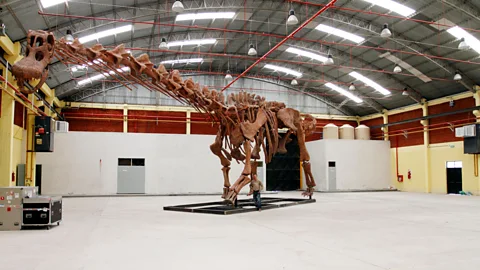 Alamy
AlamyVinther walks me over to his prized possession, and talks me though its backstory.
It's the Early Cretaceous in the Jehol Biota – an ancient ecosystem in northeastern China. Let's say it's a beautiful sunny day in this temperate land, and the little psittacosaurus decides to leave her densely forested home to go for a drink in one of the area's many lakes. She's around three feet (91cm) long from head to tail – reminiscent of an unusually stocky Labrador – and nearly a full adult, but she's still inexperienced.
The psittacosaurus potters over to the water's edge on two feet – she stopped walking on all fours as she got older – but then tragedy strikes. Just as she's leaning down for a sip with her parrot-like beak, she slips, falls in and drowns. As she plunges to the bottom of the lake, she ends up inelegantly splayed on her back – accidentally preserving her genitals for future apes to wonder over.
Naturally, Vinther is particularly keen for me to check out this famous bottom. He points out a dark, round patch of skin just below her tail – and there it is: a dinosaur's private parts, preserved against all odds since the Early Cretaceous, a time so distant that it's equivalent to around 1.6 million average human lifespans.
Alas, the psittacosaurs in Vinther's office is not the actual fossil – what I'm looking at is a scale model of the animal as it would have been in life, that he commissioned himself. But what a model it is – painstakingly crafted to be as accurate as possible, even the markings are accurate, based on the exact streaks found on the fossilised skin of the original.
So, what does this little dinosaur's rear quarters tell us?
First up, like the closest relatives of dinosaurs – birds and crocodiles – this individual has a cloaca. These multipurpose openings are common in all land-living vertebrates except mammals, and involve a single orifice through which they defecate, urinate, have sex and give birth. This was not unexpected, but is a new discovery – no one had ever confirmed that dinosaurs had the same anatomy as their evolutionary cousins.
"So you can see, if you look underneath here [he gestures towards the psittacosaurus' cloaca, under its tail] – there's lots of pigment," says Vinther. He explains that this is melanin, and it might be partly responsible for the extraordinary level of preservation in this specimen.
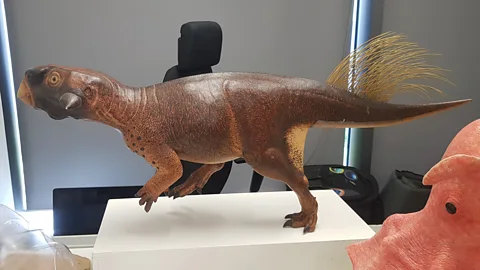 Zaria Gorvett
Zaria GorvettThough we tend to think of melanin as the dark compound that gives our skin its colour, it has a kaleidoscopic range of uses in the natural world, from its application as a pigment in squid ink to its function as a protective layer at the backs of our eyes. It's also a potent antimicrobial – in amphibians and reptiles, it's commonly found in high concentrations in the liver, where it prevents the growth of potentially harmful microbes. But crucially, it's also found in many other situations where this would be useful.
"For example, the insects… they use melanin as a sort of immune system to protect against infection. So if you poke a hole in a moth, for example, with a needle [this is not recommended], then the area around where you poke the hole will secrete melanin," says Vinther.
For this reason, many animals, including humans, have higher concentrations of melanin – and therefore, darker skin – around the genitals. And this is just as true for dinosaurs as it is for humans. Looking at the distant relative in front of me, who – as one of my colleagues pointed out – is frozen in a pose as though they're trying to tiptoe past me, it feels odd to recognise such an intimate similarity.
But there are other intriguing finds, and here it becomes clear that all my discomfort so far has merely been a warm-up. Before I know what's happening, Vinther is enthusiastically explaining the many other features of the psittacosaurus' bottom in an arresting level of detail.
"Now we can reconstruct the morphology of the cloaca, and we can show that it had like sort of two sort of lips that sort of flared out like this," says Vinther, making a V-shape with his fingers. "And on the outside, there were pigmented. But here's the interesting thing, because it's not around the opening, [as it would logically be] if it was for microbial infection. So they were they putting pigment there to advertise."
If this is true, it would be unprecedented – advertising your bottom to potential mates, as baboons do, is extremely unusual in modern birds, the descendants of the avian dinosaurs. "They use a lot of visual signalling," says Vinther, explaining that they have excellent colour vision – unlike most mammals which can only see two colours, birds can see the three humans can as well as ultraviolet light. "But it's pointless to show your cloaca because it's covered in feathers." Equally, crocodiles rely more on scent.
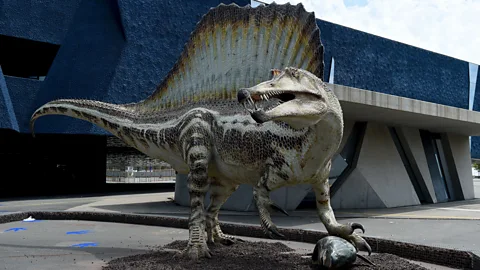 Getty Images
Getty ImagesVinther speculates that like birds, dinosaurs may also have had excellent colour vision, in which case it makes sense that those that lacked feathers may have taken the opportunity – "why not advertise your cloaca?", as he puts it.
Unfortunately, it's not possible to tell if the psittacosaurus in question is male or female, or exactly what kinds of sexual organs they possessed, because its respective body parts are hidden within. This leaves dinosaurs with two possible mating strategies – the (shudder) so-called "cloacal kiss", in which two dinosaurs would have lined up their cloacas, with the male ejecting his semen directly into the female's – a common strategy among birds– or the more familiar version, where there's a penis involved (how crocodiles do it).
Without further evidence and with zero other fossilised dinosaur cloacas to go on, the jury is still out.
But that's probably quite enough about dinosaur genitalia. What about the other aspects of their reproduction – did they have mating rituals, perhaps fights or even elaborate dances? Did the males and females look different? And how can we tell which features were for impressing the opposite sex?
A sexy sail
At first thought, it might seem that decoding the mating behaviours of long-extinct animals is almost as impossible as searching for their bottoms – but Rob Knell, an evolutionary ecologist at Queen Mary, University of London, assures me that there are some clues hidden in the fossil record.
"So, one of the things about dinosaurs is that there's lots of weird stuff – what some people have called 'bizarre structures'," says Knell. "It's part of their charismatic attraction. So, the plates on stegosaurus, the big sail on Spinosaurus, the frill and the horns of triceratops and all the other ceratopsians… The big crest that the hadrosaurs had… these are all things that are good candidates for being sexually selected traits."
In many cases, scientists have been debating the functions of these structures for centuries, such as the outlandish theory that hadrosaurs were aquatic, and used their crests as snorkels or air chambers. Sometimes they were too weird to even seem plausible – when T. rex was first discovered in 1900, its arms were almost deemed too small to belong to it – initially they were thought to have been from another skeleton.
 Wikimedia Commons/ ケラトプスユウタ
Wikimedia Commons/ ケラトプスユウタBut Knell explains that in the past, palaeontologists have been reluctant to interpret them as tools for attracting or competing for mates – they could guess that this was their ultimate purpose, but with no way of proving it speculation seemed unscientific.
"An example would be the plates on the back of the stegosaurus, " says Susannah Maidment, a senior researcher in palaeobiology at the Natural History Museum in London. "[Or] we have these sort of tubular crests on the heads of hadrosaurs… we don't know what they're for."
Enter modern science. Back in 2012, Knell decided to take a closer look at the problem. He was particularly interested in studying the eccentric features that closely resemble the mating displays of living animals, or those that have defied other forms of explanation. These include the facial horns and frills of triceratops and its relatives – such as the psittacosaurus, which has unusual sideways spikes on both its cheeks – the head crests of predators like Dilophosaurus, which has two prominent ridges above each eye, the long necks of giants like Diplodocus, and the feathers in the ancestors of birds.
Though there is no definitive way to determine what these weird anatomical flourishes were used for, Knell – together with an international team of scientists – quickly realised there are some strong hints in living animals, if you know where to look.
One is sexual dimorphism – where the males and females of a species look different. It's rare for the two sexes to have totally different lifestyles and strategies for survival, so when they've got different features they're usually so that the males can directly attract females (such as male peacocks' colourful cloaks of feathers) or compete against each other for the right to mate (such as the horns of stags).
Unfortunately this particular hint is not that useful for understanding dinosaurs, since scientists can't yet tell the males and females apart – even when they do discover discrepancies between fossilised individuals, they have no way of knowing whether they're looking at different sexes, or different species.
And this brings us to the next tell-tale sign. When a feature only appears in mature adults, and not in the babies or juveniles, it's often for sex – like the manes on male lions, which are thought to signal their eligibility. However, this one can also be tricky.
Back in 1942, scientists unearthed a striking new skull in Montana, in the US. It clearly belonged to a formidable predator, but was relatively small and slender compared to those of the ultimate predator king, T. rex. The team concluded that this was an adult from a new species, and eventually – after many decades of debate – the discovery was named Nanotyrannus. Over the coming years, several more possible examples were identified.
Then in 2020, a team took a closer look. They analysed the bones of two possible pygmy tyrannosaurs, and realised that these were likely never a different species after all – instead, they're were T. rexes who had died during their gangly teenage phase. In fact, it's now thought that these smaller, juvenile animals would have been so distinct from the adults, they almost performed like they really were unrelated – with each occupying its own distinctive niche in the prehistoric food chain.
And T. rexes are not the only dinosaurs that might have undergone dramatic changes as they developed.
"There's a huge debate about torosaurus and triceratops," says Maidment. While both dinosaurs look broadly similar, the former has a truly gargantuan skull – one of the largest of any land animal – with an oversized ruff around its neck with giant holes in it. The latter is much smaller, with a correspondingly smaller – and hole-free – frill.
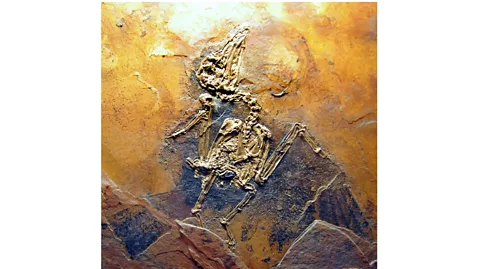 Alamy
Alamy"These are two dinosaurs that lived alongside each other, right at the end of the Cretaceous in North America. And some people think that Torosaurus is a very old triceratops, and some people think that they're two separate species," Maidment says, listing the other variants that some people believe are just different life stages of triceratops. "And people have argued that these are all separate species, but actually, they might just be ontogenetic [developmental] stages of triceratops. And nobody really agrees."
So, this strategy for identifying sexy traits won't always work either. But luckily, there is another way – and that's to model what else the structure might be useful for.
"What we can do is say, 'well, this is consistent with it being a structure that evolved for this purpose. And it's not consistent with it being a structure that evolved for any other purpose'," says Knell.
One example is the frill of triceratops. Over the years, successive generations of scientists have been baffled by this outsize feature – with explanations ranging from protecting its neck from predators to regulating its temperature or even just providing somewhere for muscles to attach, so that it can wield its horns more powerfully.
More recently, it's been suggested that it might have been used to help the species identify members of its own group. So, Knell and colleagues investigated further, and found that this idea doesn't really work – there is little variation between the frills of different triceratops species, so this is unlikely to have been their purpose. With this theory potentially discounted, it becomes more reasonable to speculate that they were used to impress other triceratops or fight off other males – that they helped them to get laid.
And there is some evidence for this. In one 2009 study, patterns of injuries on the skulls of several triceratops individuals were analysed, and found to be consistent with fights with other triceratops. The researchers may have found the ghostly signatures of ancient sexual rivalries.
But what about other mating rituals – would male T. rexes really have wriggled their tiny arms around to entice females to mate, as the producers of Prehistoric Planet have recently suggested? Is it possible that pachycephalosaurs butted heads in battles of sexual dominance? And might male velociraptors have built elaborate, carefully curated bowers – perhaps selecting only the bluest berries to adorn their masterpieces?
 Getty Images
Getty ImagesKnell is convinced that, broadly speaking, they would. He points to the similarities between dinosaurs and birds, and the fact that the latter are just beaked, toothless continuations of their ancient feathered cousins. This is particularly true of the avian dinosaurs, which evolved into modern birds – such as velociraptors, which were more like murderous turkeys than the sleek predators shown in the Jurassic Park franchise.
"If you look at birds nowadays, there's a huge range of displays that they do. And why would the dinosaurs have done anything differently?," says Knell. "There's no reason to think that there was something odd about dinosaur mating that that hasn't carried over into the birds… so yeah, I think I think I think they would have had strange mating displays."
Amazingly, there may even be physical evidence of these antics. In 2016, scientists were digging in Colorado when they uncovered some peculiar troughs in the rock bed, almost like ancient puddles.
However, a closer inspection revealed detailed scrape-marks and three-toed footprints, the hallmarks of predators such as T. rex, dating back to the Cretaceous. These weren't incidental undulations in the surface of the land – they were made by dinosaurs. And they look uncannily like larger versions of the impressions made by ostriches today.
Female ostriches are picky lovers, and males must perform elaborate courtship dances to get them in the mood. This includes a race, much waving of wings, and a "scape ceremony" – a demonstration of their digging skills, which are required to build their nests on the ground. The researchers suggested that authors of these marks may have been doing the same, 100 million years ago.
However, Knell suggests that we may never know much about the quirky details of most dinosaur mating rituals. Even closely related species alive today, such as the various birds of paradise, can have widely divergent displays. "And if you were going to try and predict what they were, you wouldn't get very far," he says.
Then again, in recent years we have gained many previously unimaginable insights into dinosaur lives – who knows, perhaps in a few decades we'll all know an uncomfortable amount about the perverted ways they courted – and yes, what kind of genitals they had.
--
Zaria Gorvett is a senior journalist for BBC Future and tweets @ZariaGorvett
--
